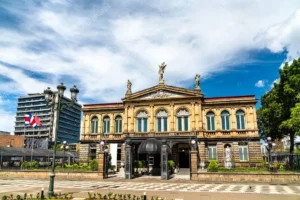
National Theatre of Costa Rica: A Cultural and Historical Gem of the Country
The National Theatre of Costa Rica: history, neoclassical architecture, and cultural programming that make it a heritage symbol of the nation.
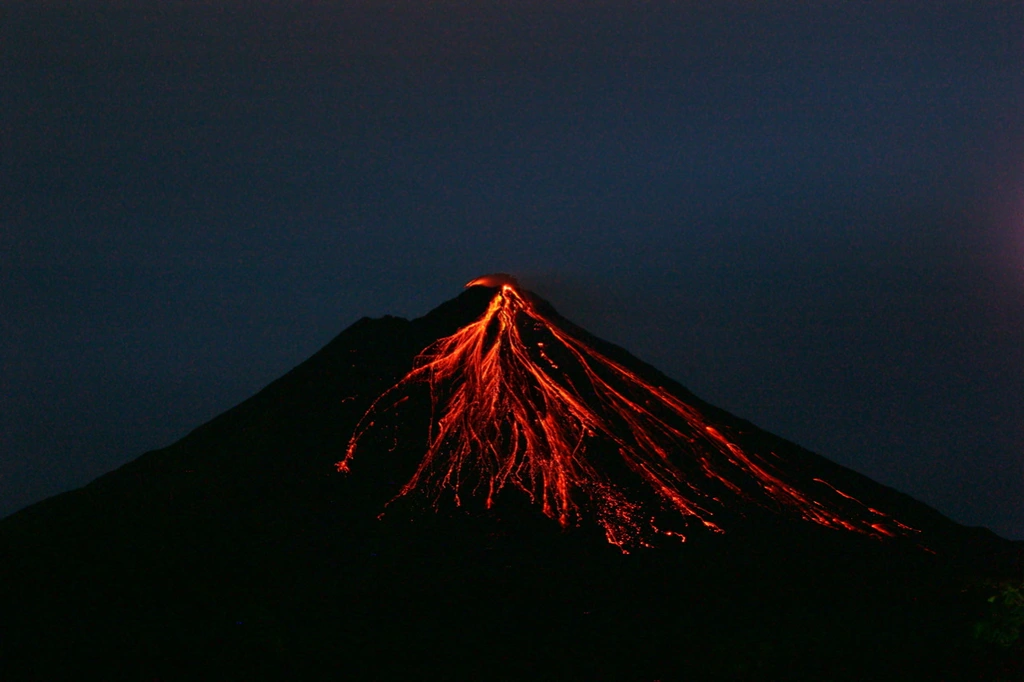
Portada » The Sleeping Giant of Arenal: From Unforeseen Fury to Engine of Sustainable Costa Rica
In the green heart of Costa Rica, where the jungle kisses the clouds, rises the imposing silhouette of Arenal Volcano. For many who gaze upon it today, with its near-perfect conical shape etched against the sky, it's hard to imagine that this giant, now in a peaceful slumber, once awoke with a fury that would forever transform the lives of a region and mark the beginning of a remarkable story of resilience and sustainability. Join us as we unravel the secrets and significance of Arenal Volcano.
Before becoming the tourist magnet we know today, Arenal Volcano was a sleeping enigma. For centuries, locals saw it simply as another mountain, cloaked in dense vegetation. Little did they know that beneath its surface beat a heart of fire. This young stratovolcano is estimated to have begun forming around 7,500 years ago, but it was on July 29, 1968, that its story took a dramatic turn.
On that day, a violent, sudden, and unexpected eruption shook the earth. The towns of Tabacón, Pueblo Nuevo, and San Luis were devastated by pyroclastic flows and lahars. The tragedy left an indelible mark, but it also marked the birth of the Arenal we know today. Three new craters opened on its western flank, and for over four decades, the volcano maintained near-constant activity, offering spectacles of incandescent lava and explosions that captivated the curious eyes of the world. Since 2010, the giant has entered a period of calm—a respite in its volcanic life cycle—but its vigilance continues, reminding us of its latent power.
The 1968 eruption, though painful, planted the seeds of an unprecedented economic transformation. What was once a land of agriculture and livestock reinvented itself, fueled by the fascination generated by the active volcano.
The constant volcanic activity became a magnet for adventurers and nature lovers. The small community of La Fortuna, near the volcano, experienced exponential growth. Farmlands transformed into hotels with volcano views, restaurants offering unique culinary experiences, and spas harnessing the thermal waters born from the earth's internal heat. Countless jobs were created, attracting people from across the country in search of new opportunities.
Arenal Volcano emerged as a crown jewel of Costa Rican tourism. Its image spread worldwide, drawing thousands of visitors each year. The region solidified itself as a cornerstone of the country's tourism economy, generating significant income and positioning Costa Rica as a leader in ecotourism.
The story of Arenal Volcano is also one of learning and adaptation. The creation of Arenal Volcano National Park in 1991 was a crucial step to protect the area's rich biodiversity and ensure responsible tourism development.
Today, Arenal is an emblem of sustainable tourism. Local businesses have adopted practices aimed at minimizing environmental impact, supporting neighboring communities, and educating visitors about the importance of conservation. From safeguarding hot spring sources to promoting low-impact activities, Arenal shows us how nature and tourism can coexist in harmony, generating economic benefits while preserving invaluable natural heritage.
The majestic Lake Arenal, Costa Rica's largest artificial lake, stretches at the foot of the volcano. Its waters not only offer breathtaking landscapes but are also vital for the country's hydroelectric power generation.
Beneath the surface, volcanic activity heats groundwater, giving rise to the famous Arenal hot springs—a gift of nature that attracts thousands of visitors seeking relaxation and wellness.
The volcano's slopes and the national park are a melting pot of life, hosting astonishing biodiversity where tropical rainforest and cloud forest intertwine, offering a unique natural spectacle.
Its near-perfect conical shape isn't just a visual marvel but also the result of thousands of years of eruptions and volcanic material accumulation, making it one of the most photogenic volcanoes on the planet.
Arenal Volcano is far more than a mountain; it's a testament to nature's power, human adaptability, and the potential of sustainable tourism. Its story, marked by fury and transformation, continues to unfold with every sunrise that illuminates its majestic silhouette.
| Date/Period | Key Event |
|---|---|
| ~7,500 years ago | Formation of Arenal Volcano begins, making it one of Costa Rica's youngest volcanoes. |
| Pre-1968 | The volcano is a "sleeping giant," covered in vegetation and considered an inactive hill or mountain by locals. |
| July 29, 1968 | A violent Pelean-type eruption occurs, destroying the towns of Tabacón, Pueblo Nuevo, and San Luis. This marks the start of a period of continuous activity. |
| 1968 – 2010 | The volcano enters a phase of constant activity, with lava flows, gas emissions, and ash, becoming one of the country's top tourist attractions. |
| 1991 | Arenal Volcano National Park is established to protect the area's biodiversity and promote sustainable tourism. |
| October 2010 | The volcano enters its current dormant phase, with a drastic reduction in visible activity. Though still monitored, lava flows are no longer observed. |
| Present Day | Arenal Volcano is a symbol of sustainable tourism and one of Costa Rica's most visited regions, renowned for its hot springs, trails, and the beauty of Lake Arenal. |

The National Theatre of Costa Rica: history, neoclassical architecture, and cultural programming that make it a heritage symbol of the nation.
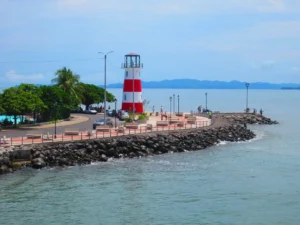
Puntarenas Lighthouse: history, economic impact, and its legacy as an iconic symbol of Costa Rica's Pacific coast.
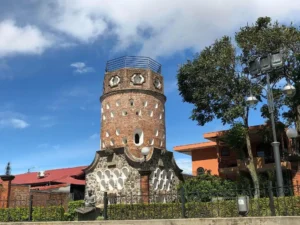
Fortín de Heredia, an emblematic Costa Rican fortification that symbolizes vigilance, defense, and community commitment.

How drummer Juan Santamaría became Costa Rica's hero by burning Walker's fortress in 1856. Explore his legacy today.

Does your mom have a special quote? Share it and win a prize at Ponderosa. Let's honor her love this Mother's Day! 💖
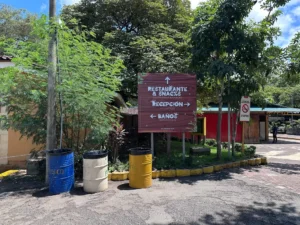
Ponderosa in Costa Rica strengthens its environmental commitment by collecting and delivering 170 kilos of recycling to the Municipality of Liberia.

The National Theatre of Costa Rica: history, neoclassical architecture, and cultural programming that make it a heritage symbol of the nation.

Puntarenas Lighthouse: history, economic impact, and its legacy as an iconic symbol of Costa Rica's Pacific coast.

Fortín de Heredia, an emblematic Costa Rican fortification that symbolizes vigilance, defense, and community commitment.

How drummer Juan Santamaría became Costa Rica's hero by burning Walker's fortress in 1856. Explore his legacy today.
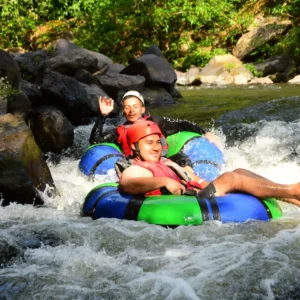
⏱️40 Minutes | 💦Guaranteed Fun | 👪 Family Activity
Fluye con la corriente en el Lazy River Float de Ponderosa.
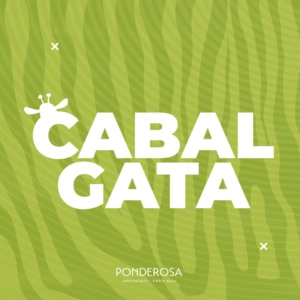
⏱️1 Hour | 🏇 Horseback Riding | 👪 Family
Conéctate con la naturaleza en la cabalgata de Ponderosa. Un recorrido a

⏱️1-2 Hour | 🚜 Guided Tour | 👪 Family Activity
Disfruta de una aventura inolvidable en el Safari Tour de
To provide the best experiences, we and our partners use technologies like cookies to store and/or access device information. Consenting to these technologies will allow us and our partners to process personal data such as browsing behavior or unique IDs on this site and show (non-) personalized ads. Not consenting or withdrawing consent, may adversely affect certain features and functions.
Click below to consent to the above or make granular choices. Your choices will be applied to this site only. You can change your settings at any time, including withdrawing your consent, by using the toggles on the Cookie Policy, or by clicking on the manage consent button at the bottom of the screen.
Utilizamos tecnologías como las cookies para almacenar y/o acceder a la información del dispositivo. Lo hacemos para mejorar la experiencia de navegación y para mostrar (no-) anuncios personalizados. El consentimiento a estas tecnologías nos permitirá procesar datos como el comportamiento de navegación o los ID's únicos en este sitio. No consentir o retirar el consentimiento, puede afectar negativamente a ciertas características y funciones.